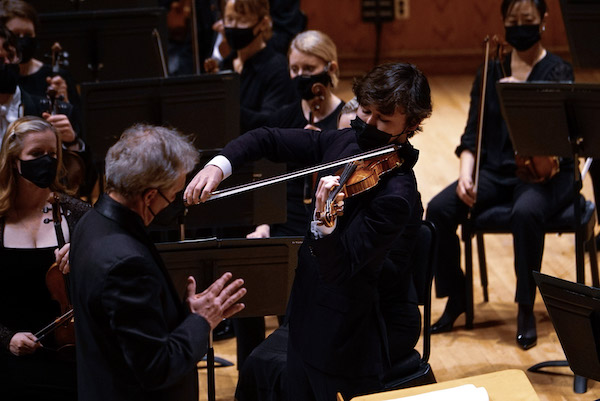A Brazilian gem and Swedish phenom strike sparks with Fischer, Utah Symphony

Utah Symphony music director Thierry Fischer is on a roll. Perhaps the five months he spent apart from the symphony during the first half of this season gave both parties the chance to grow and appreciate one another more. Or maybe it’s just the programming. Whatever the reason, Fischer’s three concerts since his return have been among the best of his 12-year tenure.
The first half of Friday’s concert at Abravanel Hall featured two highlights of the orchestra’s season to date: the U.S. premiere of Brazilian composer Paulo Costa Lima’s wildly original Ojí — Chegança e Ímpeto and the triumphant Utah Symphony debut of rising star violinist Daniel Lozakovich playing Tchaikovsky’s Violin Concerto. With selections from Prokofiev’s ballet Cinderella, the concert’s second half showcased the rich, full sound Fischer has been cultivating in the orchestra.
Ojí — Chegança e Ímpeto, (“Arrival and Impulse”) starkly juxtaposes European art music, Afro-Brazilian rhythms, and pastoral sonorities to take the listener on a post-modern, post-colonial journey meant to depict what Lima called “the metaphor of the Atlantic crossing.” Born in 1954 in Bahia — a Brazilian state where African, European, and Native cultures are juxtaposed — Lima belongs to an alliance of Bahian composers with an inclusive aesthetic and a Dadaist manifesto: “In principle, we are against all and every asserted principle.” Regardless of his group’s cheeky creed, Oji demonstrated Costa Lima’s mastery of harmony, counterpoint and orchestration to create a unique musical language.
The piece, just 8 minutes long, includes consonant open chords in the brass and strings reminiscent of Aaron Copland’s gentle ballets, moments of atonal chaos calling to mind Pierre Boulez, and sections that sound like a samba drum line in a parade during Carnival. Oji keeps six percussionists busy playing a total of 12 instruments including marimba, vibraphone, xylophone and glockenspiel as well as timpani, tom-tom, whip and rattle. The heavy percussion also makes way for strikingly intimate moments, including an earnest, longing oboe passage near the end.
Fischer, who serves as music director of the Sao Paulo Symphony in addition to his post in Utah, conducted the piece’s world premiere in Sao Paulo in 2020, and his performance Friday underlined its many styles and contrasts. He was at his best in moments where percussive chaos instantly gave way to warm, reassuring chords, and he showed a sense of the piece’s phrasing and architecture.
As unique as the Lima was, it was 20-year-old Lozakovich’s brilliant rendition of the Tchaikovsky Violin Concerto that had the audience talking at intermission and after the concert. The piece is designed to showcase a soloist’s musicality and technical skill in equal measure, and many of the world’s great violinists have put a personal stamp on it. What set the young Swede’s performance apart was his natural connection to the music — and his ability to get out of its way.
His first entrance was tender and sweet, rather than commanding, and he played with a light touch that made the listener lean in. His variations in tone and articulation accentuated the beauty of the melody and fostered strong repartee with the string section, each reacting to the other’s phrasings.
The orchestra’s entrances were glorious, with a full sound, alluring lilt and perfect intonation, and they beautifully set up Luzakovich’s captivating first movement cadenza. Taking his time and using his whole technical toolbox, he explored the music as if he was experiencing it for the first time, with the audience allowed to watch him in a scene of private reflection.
Luzakovich approached the second movement quietly and seriously, his vibrato deepening as the melody turned from mournful to pleading. His tone became lighter as the melody resolved into a more hopeful major key and lighter still as the galloping third movement broke in. Here, Luzakovich was clearly having fun as he showed off his dazzling technique and gave the strings a playful scrape in the main theme. His shimmering vibrato accentuated the emotion in the movement’s moodier passages, and he let loose in the concerto’s closing runs.
His encore was a stunning Sonata No. 5, Danse Rustique, by Eugene Ysaye, that gave the piece a mystical, other-worldly quality as he explored its varied sonorities.
In his ballet score for Cinderella, Prokofiev said his aim was to make the title character a “real person,” and his music highlights the darker, more ambivalent aspects of the story. The ball is beautiful, but also anxiety-inducing and the impending midnight is terrifying.
In the eight selections they played from the score, Fischer and the orchestra captured the shimmering, emotionally fraught world of the story with charm and grace. The highlights were the rapturous “Waltz Melody” and the ecstatic “Amoroso” that concluded the piece. These had the feel of a Strauss waltz, but with more interesting harmonies and counterpoint, highlighted by Fischer’s gorgeous phrasing and swells in the strings. Fischer plumbed the emotional depth of the piece without sacrificing its elegance or lilt, and the sound the orchestra achieved was breathtaking.